The projector rainbow effect is a visual phenomenon where someone watching a projected image perceives flashes of color around the image.
In a nutshell, it is a “stroboscopic” effect produced by slow color wheel speeds in a DLP projector that causes some people to see flashes of blue, green and red particularly with scenes containing fast movement, when very bright areas move across dark areas in a video.
The rainbow effect is also referred to as RBE and rainbow artifacting. Only DLP projectors are impacted by the rainbow effect.
It is a strange anomaly as some people see the rainbows, and some don’t, or at least it isn’t a noticeable issue to them.
What Does The Rainbow Effect Look Like?
The rainbow effect could be described as flashes of color that's usually seen out of the corner of your eye as opposed to straight on. It appears as though there are distinct red, yellow, green and blue outlines that follow the edges of objects. It’s almost like everything moving quickly on the screen is trailed by a slight rainbow aura for a very brief moment.
You can see the rainbow effect captured in this shot trailing behind the policeman’s head.
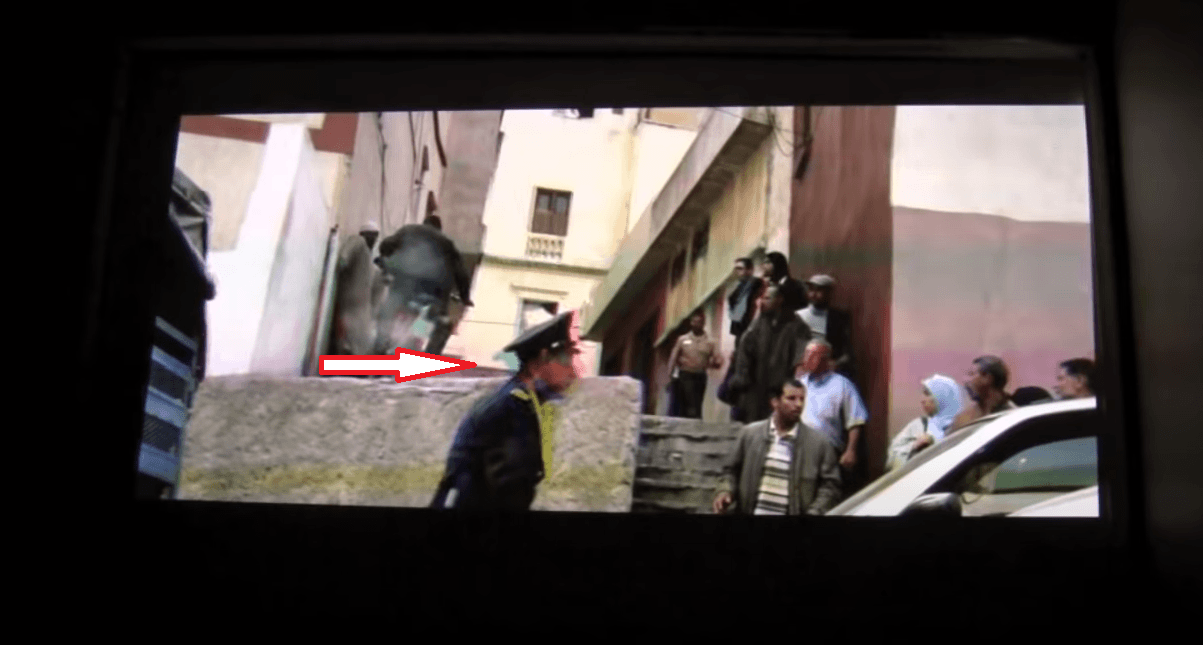
Here is an exaggerated display of the rainbow effect.
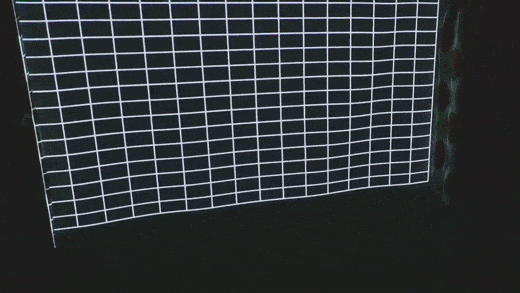
You’ll mostly see the rainbow effect when your eyes follow movement on the screen or if you move your head.
You can force yourself to see the rainbow artifact by quickly moving your head side to side. If you’re susceptible to the rainbow effect, you’ll know what it looks like if you’re looking out for it when watching content on a DLP projector.
Why Do Some People See The Rainbow Effect?
The biological explanation for seeing the rainbow effect, according to Dr. Norman Shedlo at the Eyecare Center of Maryland, is that moving objects and colors are processed by two different parts of the visual system. The magnocellular pathway processes the movement and position of objects in the field of view and the parvocellular pathway processes the shape and color of objects in the field of view.
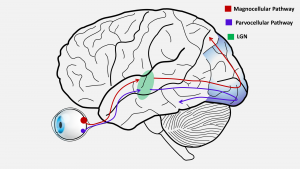
These pathways begin in the retina eye and continue to the lateral geniculate in the thalamus portion of the brain. The retinal rod cells are more sensitive to movement and the cone cells are more sensitive to color.
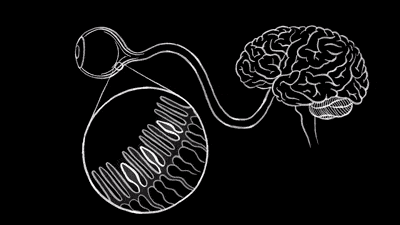
A slight mismatch in the signals the brain is receiving from the color pathway to the ones being received from the motion pathway lead to a perception of "rainbows". This effect is similar to a video of someone speaking that is not exactly synced to the audio portion of them speaking.
How Many People Are Susceptible To The Rainbow Effect?
According to Dr. Sheldo, about 40% of individuals report noticing the rainbow effect. While that amount seems pretty high, most of these people aren’t so distracted that it ruins their viewing experience.
Why Do Some People See The Rainbow Effect While Others Don’t?
It is not fully clear as to why some people are more sensitive to the rainbow effect than others. The fact is there are some people who are just more biologically susceptible in seeing this effect.
That said the reason some people see the rainbow while others don’t is likely due to differing eye and brain anatomy that may have different lengths and quality of the magnocellular and parvocellular pathways. Dr. Barrett Eubanks, an ophthalmologist with Eye Mountain.
Dr. Yuna Rapoport from the Manhattan Eye Clinic says it seems that susceptibility is a genetic trait. However it has not yet been mapped out to a single chromosome, and is likely genetically multi-factorial. Interestingly there is no correlation with rod-cone dysfunction, or with red-green or yellow-blue color-blindness.
How Do I Know If I’m Susceptible To Seeing The Rainbow Effect?
In the end, you have no way to really know if you are susceptible to the rainbow effect artifacts until you actually take the time to go sit down and see one for yourself, which is highly recommended before you buy. You also have to take into consideration your family members and those who will be watching with you the most, as they may be affected by this even if you aren’t.
You could also use prior experiences with DLPs as a gauge. If you recall not seeing RBE on an older generation machine, then there is extremely little chance you will see them with newer projectors either. If you have seen them, but they weren’t bothersome to any real extent, then it will only be better with the newest DLP projectors to hit the market.
What Causes The DLP Rainbow Effect?
In order to fully understand what causes the rainbow effect, you first need to understand how DLP projectors work.
The Technology Behind DLP Projectors
So what is DLP? DLP stands for Digital Light Processing and it is a projection technology developed by Texas Instruments that allows a projector to create the image you see on the cinema screen.
We’ll give you a brief explanation here but for a more in depth look into DLP technology, see our extensive blog article posted here about how DLP projectors work.
In a nutshell, though, a DLP imaging chip is a reflective surface made up of multi-thousands to millions of microscopic mirrors, depending on the native resolution of the chip, each representing a single pixel in the entire video frame.
It is very different from other technologies such as SXRD, LCoS, LCD and the like. Those technologies feature glass imaging panels with substrates where the lamp’s light is either passed through directly for LCD or in the case of LCoS/SXRD, light is passed into it and reflected back out.
DLP chips, or DMDs (Digital Micromirror Device) as they are known, create the image by electrostatically switching the mirror position, which can be tilted in two directions designated as "on" and "off" positions. Because the scale is so small they can do this thousands of times per second.
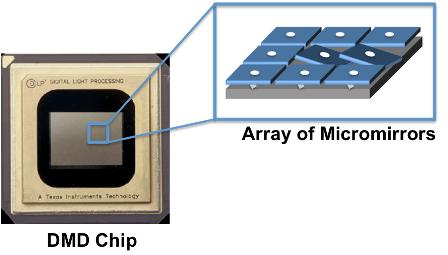
The Image is created by the light from its light source, which can be a lamp, LEDs or laser diodes, hitting the mirrors while in the on position. This would create a white pixel on the screen while the lack of light hitting the mirrors in the off position would create a black pixel. The light reflected by the mirrors in the off position hits a heat sink within the projector that absorbs the light.
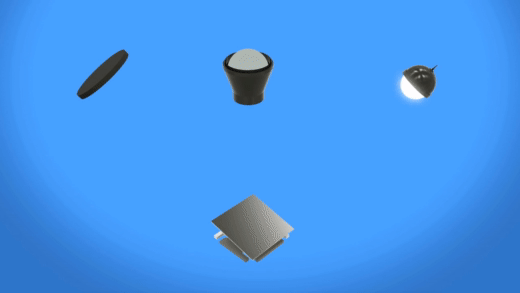
In high end home theater and commercial theater DLP projectors, there are typically three separate DMD/DLP chips, usually larger sized ones, similar to the other technologies LCD, LCoS, SXRD. Like those, it has one DMD each for the Red, Green, and Blue colors. Then those colors are overlapped and converged before going through the lens and out to your screen. For those with more limited budgets than the high end and commercial realms allow, most affordable consumer and economical business DLP projectors feature only one DLP chip.
So How Does The DLP Projector Get Its Colors?
The secret to creating the colors depends on the light source. Lamp based DLP projectors use a UHP or other type of lamp that radiates white light. The light from the lamp is first focused through a condensing lens. The white light itself can’t create a full color picture, so there has to be a way of splitting that light into the individual colors red, green and blue, which when combined make up the white light.
DLP light engines achieve this by passing the light through a spinning color wheel. The color wheel consists of, at minimum, red, green and blue filter segments that spin in front of the lamp to create the primary colors, flashed one after the other onto the DLP chip sequentially.
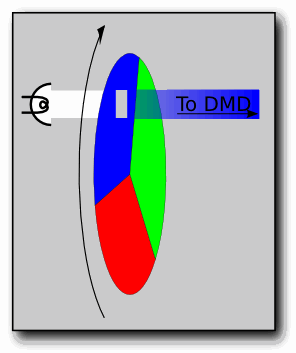
LED and Laser projectors can also use DLP chips to create the image. Instead of using white light, these projector images are powered by colored lights that skip the color wheel entirely in the case of LED and triple laser projectors, or use a single blue laser that is run through a yellow phosphor wheel to create the white light that is then shone through the color wheel. Regardless of the light source, the colored light is then directed to the mirrors on the DMD chip.
So how does this make a colored image?
Let’s use blue as the first bit of light that arrives at the DMD chip after it passes through the color wheel’s blue segment as an example. At the time the blue light strikes the chip, all of the mirrors which correspond to blue should appear within the image and will turn “on”. When the pixel is turned “on”, it directs the blue light out of the lens and to your screen.
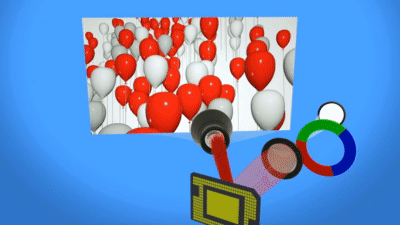
For the places that contain no blue, or no color that is composed of blue, the mirror is turned “off” and the light is then directed away from the lens and to a light collection space within the projector. The same is then also done for each of the other colors on the color wheel in sequence. This is done fast enough to create the full color image on screen, while being imperceptible to the human eye.
At least in theory.
How Does Color Wheel Create The Rainbow Artifacts We See?
While the color wheel spins the image on the screen is either red, or green, or blue at each instant in time.
The entire way that this technology works is that it relies on our eyes combining the three separate colors in our minds, and hopefully not detecting the extremely fast color changes from red, green and blue in sequence.
A similar practice was done in the beginning of television with interlacing, where the odd fields, or lines of the TV image, were scanned first onto the CRT, and then the even lines were drawn after and in between the odd ones, combining on our eyes and minds to create a full frame video image. Many complained of “combing” artifacts with this technology, and now rainbows are the “artifact DuJour” in the age of the DLP!
When first introduced, DLP projectors used color wheels that spun at 60Hz. These used a single segment for each color, so one red, one green and one blue. This version then made each color flash 60 times for every second and what we now call a 1X Color Wheel system.
Because the average human eyes have persistence of visions of about 1/60th of a second, the flashes all blur together to form a single full-color frame in 1/60th before a new frame is presented on the screen.
The problem with a color wheel spinning at 60Hz however, is that if the eye is moving in the extreme peripheral vision area, such as during a fast moving action scene, the eye may pick up the red, green, and blue images at slightly different positions on the retina, causing you to see a split of colors like a rainbow.
The dreaded rainbow effect strikes again!
How Do I Stop Seeing The Rainbow Effect On My Projector?
Unfortunately there is no way to completely stop seeing the rainbow effect if you are susceptible. However there are some things you can do to reduce its impact.
Here are some steps you can take to try to minimize the rainbow effect:
- Buy an LCD projector instead
- Power through and keep watching, the more you watch the more you get used to the effect until it becomes unnoticeable.
- Dimming the ambient light in the room or turning the lights off completely.
- Try lowering the brightness settings on your device.
- Lower the contrast on the projector.
- Use a gray projector screen (you’ll also get better black levels.)
- If there is a setting to allow it, try turning up the color wheel speed, so that the image processing time is faster.
- There is software out there you can download which removes rainbows by adding a shadow effect, but many who’ve tried this say that it seriously diminishes the picture quality.
- Minimize movement while watching media on a projector.
Dr. Bosung Kim, an optometrist from Della Optique, recommends that you avoid chairs that swivel or swing back and forth, prevent children from fidgeting on your lap, and even avoid or minimize food and drink due to the movement from chewing and swallowing.
Are Rainbow Artifacts Becoming A Relic Of The Past?
While the rainbow effect is often brought up as an issue with DLP projectors the fact is that most everyone who watches single chip DLP do not see the rainbows, or they aren’t bad enough to distract them enough to care or move to another technology if they enjoy the many other benefits of DLP more than the rainbows distract them.
Furthermore, over the years that DLP has been out, the technology has matured year over year and they have made a concerted effort to reduce and eliminate DLP color separation rainbow effect artifacts.
New generations of DLP chipsets are being engineered by Texas Instruments, with the first being the doubling of the rotation speed to 120 times per second, or 120Hz. This lowers the delay between when each color was shown and it helps get closer to elimination of the color separation artifacts.
To further this reduction of RBE, they then also doubled the number of primary color segments on the wheel, so red, green, blue, red, green, blue.
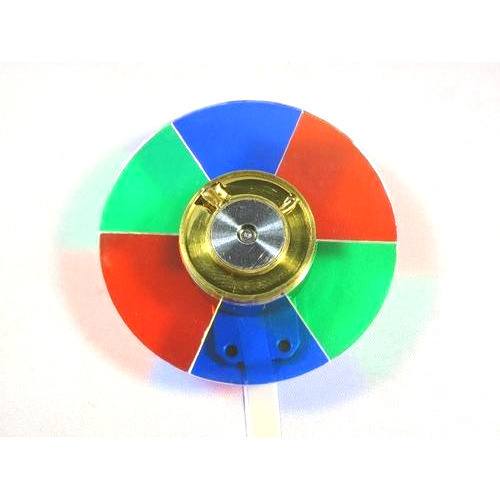
The wheel speed remained the same at 120Hz. Each color was then shown twice during each rotation of the color wheel, essentially doubling the amount each color is shown, so they in turn called this a 4X color wheel system and it even more greatly decreased the effects of color separation, almost to the point of non-existence, especially for those who weren’t very susceptible in the first place. For most users the 4X, 6 segment color wheels have solved their problem.
Adding to these updated technologies to reduce and hopefully eliminate the bane of single chip DLP’s existence, color separation artifacts are some of the newest technologies for light sources to shine onto these DLP chips, some of which eliminate having to use color wheels, and some which add phosphor wheels.
These light sources include blue laser phosphor, true RGB (Red, Green, Blue) Laser projectors like the Samsung LSP9T, LEDs, and various versions of hybrid light sources which combine different combinations of laser phosphor, native lasers (usually red and blue with phosphor for green) and LEDs.
What usually makes these new light sources better for RBE is that you can cycle the primary colors much faster than you can with a spinning color wheel, and you also don’t have what is known as the “spokes” of the wheel between the colors, which can cause their own issues, and was attempted to be rectified by something TI calls “Brilliant Color”, which is a discussion for another day. This increase in cycling speed further reduces the effects of color separation, almost to the point of being imperceptible to most everyone.
If you are still seeing rainbows at this point, then it is pretty obvious that single chip DLP is not the projection technology for you, and that is OK. There are plenty more projectors which perform incredibly and project an amazing image on screen, with other attributes such as native contrast performing even better than DLP.
At the end of the day, the best way to avoid the rainbow effect is to buy an LCD projector or a LCoS projector where you don’t have a risk of seeing the artifacting.